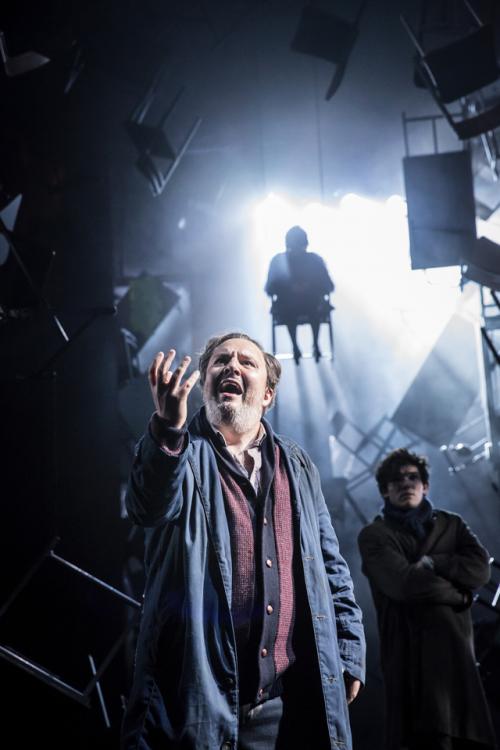Whodunnit revealed in Great Lakes Theater’s ‘absolutely enthralling’ production of Agatha Christie’s ‘And Then There Were None’
By Bob Abelman
It is a long-standing theater tradition that those who attend an Agatha Christie murder mystery must never expose its secrets to those who will be attending it next.
This tradition ends here, for this review will divulge — against better judgment and the expressed wishes of the theater’s artistic director — precisely whodunnit in the current Great Lakes Theater production of “And Then There Were None.”
But, as befits the murder mystery formula, a little context must first be presented to set up, in dramatic fashion, the big reveal.
Christie’s ingenious play is based on the best-selling author’s biggest-selling novel, written in 1939. In it, 10 individuals — strangers to each other but apparently known to their affluent but absent hosts, Mr. and Mrs. U.N. Owen — are lured to a secluded home on a private island off the coast of Devon, England.
Each one of them, we are told by a recorded message upon their arrival, has blood on his or her hands.
Over cocktails and uncomfortable conversation, the guests start dying one by one in ever more inventive fashion and in accordance with a macabre nursery rhyme called “Ten Little Soldier Boys” that is framed and hanging (yes, hanging … cue murder mystery music) by the fireplace mantel.
The original, racially insensitive title of this rhyme — which was sung as a standard in blackface minstrel shows in the United Kingdom — was the novel’s original title as well. It was subsequently changed to “Ten Little Indians,” and for obvious reasons, was changed again to “And Then There Were None,” as were later printings of the novel and adaptations for film, television and the stage.
What has this to do with revealing whodunit? Nothing whatsoever. This was just a distracting and infuriating red herring, of which there are plenty in this play.
Those left standing after each murder, and all of us sitting in the audience in the intimate Hanna Theatre, desperately try to figure out just who the murderer might be. The trick is to do so by the end of this play’s two intermissions and before the last body hits the ground.
But enough exposition about a play famous for it. Whodunnit?
Was it Jonathan Dyrud as thrill-seeking Anthony Marston, who loves fast cars, fine drink, and preferably, both at the same time? Perhaps it’s Nick Steen as the dashing Philip Lombard or Laura Welsh Berg as the Owens’ spicy secretary Vera Claythorne.
Could it be Tom Ford as the officious Honorable Lawrence Wargrave or David Anthony Smith as William Blore, a retired detective?
How about Dougfred Miller as irascible Dr. Armstrong, Laura Perrotta as cold-hearted missionary Emily Brent, or Aled Davies’ despondent General Mackenzie?
Perhaps it’s M.A. Taylor as manservant Rogers or Maggie Kettering’s Mrs. Rogers.
The answer is … yes (cue murder mystery music). All of them are responsible for turning this chestnut of a play and its game-board characters into a most remarkable, absolutely enthralling production. They all dunnit.
Leave it to Cleveland’s classic company, with an ensemble of actors trained in Shakespeare-speak and years of the Bard’s dramas and comedies under their belts, to find layers of complexity in these simply drawn characters and master the precise rhythms and melodramatic moments in this murder mystery.
Just watch these players when they are not speaking and see all that they do to add texture to the scene, build anticipation toward the next spoken line, and create dynamic tension in this production. They are in the moment every moment. And so, vicariously, are we.
And they don’t dunnit alone. Director Charlie Fee beautifully choreographs the dance these characters do as they try to expose each other without exposing themselves. Count the beats it takes a character to avoid suspicion by moving from one spot in the spacious living room to another, and then move on again, and you’ll get a sense of the intricate coordination and immense artistry that go into staging 10 actors who share the same space. And then nine. And then eight.
The spacious, gorgeous post-deco living room, a glass-enclosed rotunda that overlooks nothing but sky and a menacing crag that buttresses up against the house, is designed with superb attention to detail by Russell Metheny. It is beautifully lit by Rick Martin and enhanced with ambient sound — waves, gulls, storms (cue murder mystery music) — by Joe Court. And the period costumes by Kim Krumm Sorenson are exquisite.
Everything in this production is done with complete conviction, resulting in an evening of theater as surprising as it is engaging.
But don’t tell anyone. CV
On Stage
WHAT: “And Then There Were None”
WHERE: Hanna Theatre, 2067 E. 14th St., Cleveland
WHEN: Through March 20
TICKETS & INFO: $13-$70. Call 216-241-6000 or visit to greatlakestheater.org.
Bob Abelman covers theater and cultural arts for the Cleveland Jewish News. Follow Bob at Facebook.com/BobAbelman3.
Originally published in the Cleveland Jewish News on March 3, 2016.
Lead image: The ensemble of “And Then There Were None.” PHOTO | Roger Mastroianni











